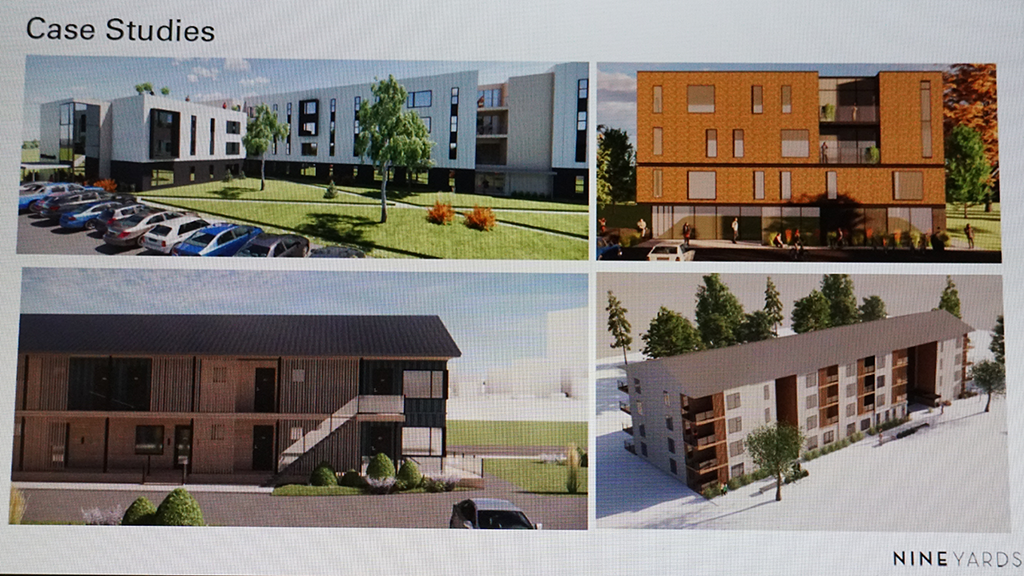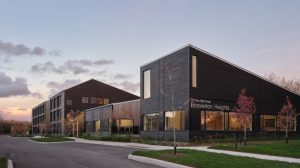Modular housing is “one of the solutions” to the housing crisis in Atlantic Canada and a Prince Edward Island-based architect is taking the medium seriously.
Nine Yards Studio has completed five modular buildings — two affordable rental apartments, two emergency shelters and one office building — since 2020 and the Charlottetown firm is part of a venture erecting two six-storey apartment buildings for seniors and families that will be comprised of 228 modules made in a factory.
“They will be by far the largest volumetric modular (self-contained units built off-site) projects in the Maritimes and across Canada really,” Shallyn Murray, architect and co-founder of Nine Yards, recently said at a WoodWorks Atlantic webinar, Designing in Modular.
She told her audience that through an integrated approach to design and construction, modular buildings rise quickly. While 80 per cent of the work is done in a factory, the builder is freed up to do other things onsite.
In the case of the six-storey apartments underway on Malpeque Road in Charlottetown, the modules will arrive onsite with completed rough-ins, flooring, kitchens and other interior finishes. The two-building affordable housing complex will contain 145 units.
The 60-foot-long units range from studios to four bedrooms. Each module is weather wrapped in an EPDM product in the factory before shipping.
Murray said instrumental in “bridging the gap” between the onsite builder and the factory is consultant 720 Modular, a firm Nine Yards has worked with on other modular projects in the region.
Kent Homes is the modular homebuilder.
While there is a perception that modular buildings are simply cookie cutter designs, Murray said there is “some flexibility” to customize units.
Nine Yards’ designs specify modules that are up to 60-feet-long-by-12-to-16-feet wide. They can be tailored in one-foot increments and one design can be easily modified for different projects.
She told the webinar because each modular box has its own ceiling, floor and walls resulting in a double floor and wall system when stacked, units have high STC ratings.
While municipal regulatory requirements can be time-consuming, Nine Yards and its team have overcome delays by ensuring each module is CSA approved and meets code requirements.
She sees modular as a housing alternative in rural regions where labour is scarce.
The supply chain squeeze faced in conventional construction is less of a problem because products are standardized and often in ready supply, she added.
Modular is not cheap in Atlantic Canada, but it offers more cost certainty than conventional construction because 80 per cent of the cost is locked in prior to site assembly, she said, adding prices should come down as the market grows and efficiencies improve.
Critical to the sector’s success is an integrated or collaborative approach from day one. On Nine Yards projects, from the first design meeting on the architect, engineer, manufacturer, modular consultant and the client meet weekly. Contractor and subcontractor input also happen during design.
Murray said criticism that modular is a “cheap solution” and “not esthetically pleasing” is not well founded.
“Most people wouldn’t know the buildings we have done are modular.”
She said Atlantic Canada faces a dire housing shortage.
P.E.I. needs 2,000 to 2,600 new housing units a year to keep pace with growth and Nova Scotia is projected to need more than 100,000 housing units by 2032.
“We can’t keep pace with the current way we do construction.”
Founded in 2017, Nine Yards has won several awards, including the Royal Architectural Institute of Canada’s Urban Design Award in 2018 and the RAIC’s Emerging Practice Award in 2020.






Recent Comments